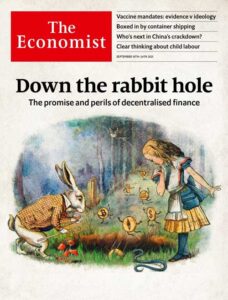This is how The Economist got its first NFT right
Through the likes of CryptoPunks, Beeple and Bored Ape Yacht Club, many will likely know NFTs through digital art. During the recent gold rush, renowned artists and novice artists alike were competing for NFT sales on the same platforms. Some were successful. Many were not. Which begs the question, why? And perhaps more importantly, what actually makes digital art NFTs valuable?
Well, it’s not much different to the fundamental formula behind the value of traditional art, or any collectable be that a vintage comic or classic car. It’s the same reasons behind the value of Michelangelo’s Mona Lisa, Cezanne’s The Card Players, or Hirst’s The Physical Impossibility of Death in the Mind of Someone Living (more commonly known as his shark in formaldehyde).
As part of its coverage of decentralised finance (defi), The Economist hit upon the same formula for success when creating and selling its own NFT. And I might mention, much to the disgust of many of the aforementioned ‘novice artists’, this was The Economist’s first NFT. Talk about beginner’s luck, right?
Or not, as the case might be.

Accompanying Alice Fulwood’s cover story on defi was the Alice in Wonderland-inspired cover art by artist Justin Metz. Justin, channelling his inner Sir John Tenniel (Lewis Carrol’s original illustrator) captures not only Alice and White Rabbit perfectly, but wonderfully shows anthropomorphised cryptocurrency coins happily hurling themselves without abandon down the wondrous rabbit hole.
Speaking of the cover art, finance correspondent Alice said
“it would make a good NFT right? We thought as much. So we decided to sell it as one… and down into the rabbit hole I went”
Cutting to the chase, The Economist minted and auctioned the NFT on Foundation. And, perhaps much to their surprise, they sold the NFT for 99.9 ETH. Which, at the time, was the equivalent of $420,000.
That’s right. FOUR HUNDRED AND TWENTY THOUSAND DOLLARS for their inaugural NFT.
Much to our approval, the net proceeds were donated to The Economist Educational Foundation (TEEF) – an independent charity that empowers young people to have high-quality discussions about current affairs.
And if that wasn’t good enough, The Economist has retained a 10% royalty stake in their NFT, enabled by the fractional ownership of smart contracts within NFTs. This means that 10% of all future secondary sales will be donated to TEEF. Thus creating a potential and lucrative source of passive fundraising for the charity.
So, what was behind this immense valuation? We believe it comes down to these few, but pivotal factors;
Scarcity
It was the very first NFT to be created by The Economist. A collector’s item if you will. And this is backed up when you look at the other pieces owned by club721dao.eth (the buyer) who owns two NFT covers by TIME Magazine. Also worth noting is that one of those TIME magazine NFTs is accompanied by the original, physical issue. A wonderful example of ‘phygital’ – where NFTs combine both physical and digital world assets.
Reputation
Beyond the fact that The Economist is renowned globally, trust in an NFT creator’s (be that a brand or artist) reputation is crucial in signalling perceived value in the first sale. Equally, these same merits create and provide further value for secondary sales too. Further value can be, and is, created when the artist goes on to produce further works. As other notable pieces rise in value, so do previous pieces or collections. A reputation (a good one, I might add) is quite literally the gift that keeps giving.
Utility & purpose
The net proceeds of the first sale (and 10% of secondary sales) are going to charity. This is an important factor that is extremely close to our own values. And one that proves the promise of philanthropic utility over the vanity that many NFTs are purchased for. I’m not bashing ‘vanity’ btw. But when a single NFT sale can be used for good, and change the lives of those in need, that’s value way beyond that of the monetary sense.
Meaningful affinity
While this is somewhat subjective (what art isn’t?) I genuinely believe the meaningful integration of style (Alice in Wonderland illustration) and subject matter (the world of cryptocurrency) had a bearing on the piece’s value. Affinity within a piece of work can be as important as the personal affinity with the piece.
So, to conclude…
There are, of course, other factors behind the success of NFTs. And not all from the Scarcity, Reputation, Utility, and Affinity formula are needed. But based on our own findings, and the first-hand experience of artists we’ve spoken to, the more of the formula’s elements you have, the better.
And might we applaud The Economist for getting right… what many fail to do after a myriad of attempts. Bravo!
Watch The Economist’s full video featuring their NFT sale in this video.

